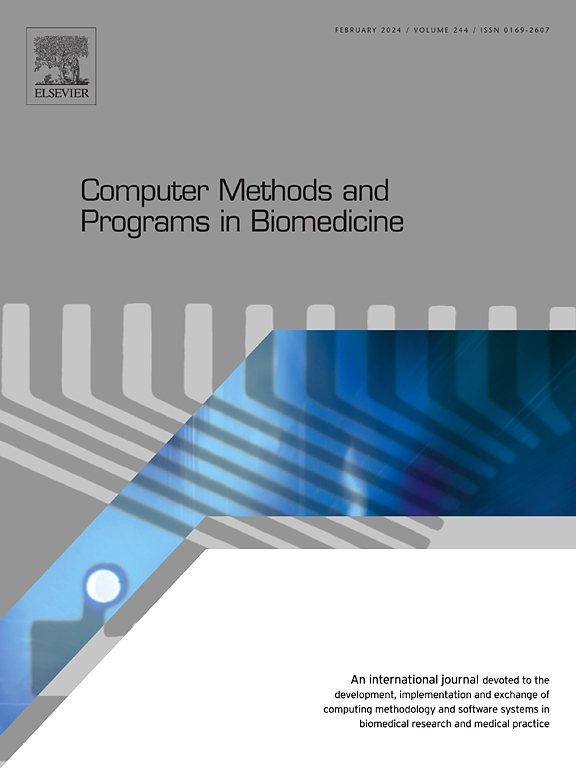Development and validation of a nomogram-based prognostic model to predict coronary artery lesions in Kawasaki disease from 6847 children in China
IF 4.9
2区 医学
Q1 COMPUTER SCIENCE, INTERDISCIPLINARY APPLICATIONS
引用次数: 0
Abstract
Background and Objective
Predicting potential risk factors for the occurrence of coronary artery lesions (CAL) in children with Kawasaki disease (KD) is critical for subsequent treatment. The aim of our study was to establish and validate a nomograph-based model for identifying children with KD at risk for CAL.
Methods
Hospitalized children with KD attending Wuhan Children's Hospital from Jan 2011 to Dec 2023 were included in the study and were grouped into a training set (4793 cases) and a validation set (2054 cases) using a simple random sampling method in a 7:3 ratio. The analysis was performed using RStudio software, which first used LASSO regression analysis to screen for the best predictors, and then analyzed the screened predictors using logistic regression analysis to derive independent predictors and construct a nomogram model to predict CAL risk. The receiver operating characteristic (ROC) and calibration curves were employed to evaluate the discrimination and calibration of the model. Finally, decision curve analysis (DCA) was utilized to validate the clinical applicability of the models assessed in the data.
Results
Of the 6847 eligible children with KD included, 845 (12 %) were ultimately diagnosed with CAL, of whom 619 were boys (73 %) with a median age of 1.81 (0.74, 3.51) years. Six significant independent predictors were identified, including sex, intravenous immunoglobulin nonresponse, peripheral blood hemoglobin, platelet distribution width, platelet count, and serum albumin. Our model has acceptable discriminative power, with areas under the curve at 0.671 and 0.703 in the training and validation sets, respectively. DCA analysis showed that the prediction model had great clinical utility when the threshold probability interval was between 0.1 and 0.5.
Conclusions
We constructed and internally validated a nomograph-based predictive model based on six variables consisting of sex, intravenous immunoglobulin nonresponse, peripheral blood hemoglobin, platelet distribution width, platelet count, and serum albumin, which may be useful for earlier identification of children with KD who may have CAL.
基于形态图的预测6847名中国儿童川崎病冠状动脉病变的预后模型的建立和验证
背景与目的:预测川崎病(KD)患儿冠状动脉病变(CAL)发生的潜在危险因素对后续治疗至关重要。方法:选取2011年1月至2023年12月在武汉市儿童医院住院的KD患儿为研究对象,采用简单的随机抽样方法,按7:3的比例分为训练集(4793例)和验证集(2054例)。使用RStudio软件进行分析,首先使用LASSO回归分析筛选最佳预测因子,然后使用logistic回归分析对筛选到的预测因子进行分析,导出独立预测因子,并构建nomogram模型进行CAL风险预测。采用受试者工作特征(ROC)和校正曲线对模型的判别性和校正性进行评价。最后,采用决策曲线分析(DCA)来验证数据中评估模型的临床适用性。结果:在6847例符合条件的KD患儿中,845例(12%)最终被诊断为CAL,其中619例为男孩(73%),中位年龄为1.81(0.74,3.51)岁。确定了6个重要的独立预测因素,包括性别、静脉免疫球蛋白无反应、外周血血红蛋白、血小板分布宽度、血小板计数和血清白蛋白。我们的模型具有可接受的判别能力,训练集和验证集的曲线下面积分别为0.671和0.703。DCA分析表明,阈值概率区间在0.1 ~ 0.5之间时,预测模型具有较好的临床应用价值。结论:基于性别、静脉免疫球蛋白无反应、外周血血红蛋白、血小板分布宽度、血小板计数和血清白蛋白等6个变量,我们构建并内部验证了一个基于nomographs的预测模型,该模型可能有助于早期识别可能患有CAL的KD患儿。
本文章由计算机程序翻译,如有差异,请以英文原文为准。
求助全文
约1分钟内获得全文
求助全文
来源期刊

Computer methods and programs in biomedicine
工程技术-工程:生物医学
CiteScore
12.30
自引率
6.60%
发文量
601
审稿时长
135 days
期刊介绍:
To encourage the development of formal computing methods, and their application in biomedical research and medical practice, by illustration of fundamental principles in biomedical informatics research; to stimulate basic research into application software design; to report the state of research of biomedical information processing projects; to report new computer methodologies applied in biomedical areas; the eventual distribution of demonstrable software to avoid duplication of effort; to provide a forum for discussion and improvement of existing software; to optimize contact between national organizations and regional user groups by promoting an international exchange of information on formal methods, standards and software in biomedicine.
Computer Methods and Programs in Biomedicine covers computing methodology and software systems derived from computing science for implementation in all aspects of biomedical research and medical practice. It is designed to serve: biochemists; biologists; geneticists; immunologists; neuroscientists; pharmacologists; toxicologists; clinicians; epidemiologists; psychiatrists; psychologists; cardiologists; chemists; (radio)physicists; computer scientists; programmers and systems analysts; biomedical, clinical, electrical and other engineers; teachers of medical informatics and users of educational software.
 求助内容:
求助内容: 应助结果提醒方式:
应助结果提醒方式:


